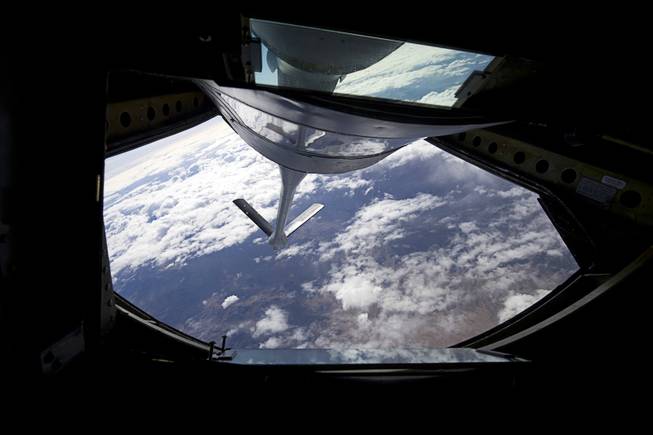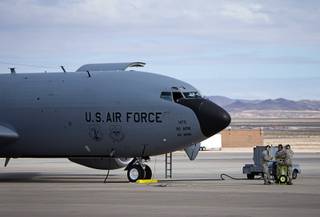
A refueling boom extends from a KC-135R Stratotanker during the Red Flag 18-1 exercise at Nellis Air Force Base Tuesday, Feb. 13, 2018.
Thursday, Feb. 15, 2018 | 2 a.m.
More than 80 aircraft have departed from Nellis Air Force Base twice daily as part of a three-week training exercise.
The training takes place about 40 miles northwest of Las Vegas over the Nevada Test and Training Range, which encompasses 12,000 square miles of airspace and 2.9 million acres of land. There’s more than 2,200 realistic threat-systems targets to provide combat air forces training they can’t receive anywhere else in the world.
Nellis hosts the exercises several times a year, allowing for U.S. and their allies’ fighter pilots to simulate scenarios they will encounter in real combat. Additionally, the exercises allow for maintenance crews, ground controllers, space and cyber operators to support those missions in the same tactical environment.
“The opportunity to come to Red Flag is a unique experience because we get a more robust and complex threat that we can face here, as opposed to other exercises,” said Richard Dickens, from Seymour Johnson Air Force Base in North Carolina, who serves as air and expeditionary wing commander for Red Flag 18-1. "A lot of that has to do with the Nellis Test and Training Range … the size of the airspace we have here allows us to train as an integrated coalition.”
Crews participate in two groups — mock enemy and coalition — then convene afterward to dissect the drill. That information can be shared with other combat teams.
The exercise changes with each drill as new scenarios are added, said Col. Christopher J. Zuhlke, commander of the Nevada Test and Training Range.
“To provide the opportunity to learn from the initial contact with the enemy, if you will,” Zuhlke said. “Then adapt to make changes. The red forces adapt as well, if the blue guys are doing the same thing day-in and day-out then they’ll make a little change to affect that as well.”
One of the training exercises includes midair refueling of various fighter jets in a simulated safe zone within the range airspace.
A KC-Stratotanker, known as the “gas station in the sky,” flies around the safe zone awaiting fighter jets, which fly aside the tanker's wings until it’s their turn to refuel. The jets then travel to the rear of the plane and dock to the extendable arm, located at the bottom rear of the Stratotanker.
The simulated event, which occurs at about 30,000 feet while traveling upwards of 500 mph, allows for boom operators inside the Stratotanker and fighter jet pilots to practice the docking and undocking to the extendable arm that’s located at the rear of the Stratotanker. The practice helps reduce the risk that an incident occurs during an actual mission.
The KC-Stratotanker can hold up to 300,000 pounds of fuel at a time. During Tuesday’s training the tanker began with 140,000 pounds of fuel and distributed 4,000 pounds of fuel to each of the four aircrafts — two F-22 and two F-16 fighter jets.

